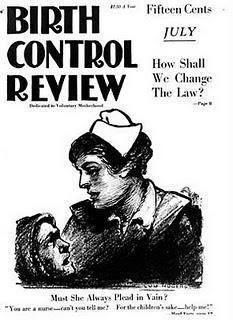 | ||
Birth Control Review was a lay magazine established and edited by Margaret Sanger in 1917, three years after her friend, Otto Bobsein, coined the term "birth control" to describe voluntary motherhood or the ability of a woman to space children "in keeping with a family's financial and health resources.". Sanger published the first issue while imprisoned with Ethel Byrne, her sister, and Fannie Mindell for giving contraceptives and instruction to poor women at the Brownsville Clinic in New York. Sanger remained editor-in-chief until 1928, when she turned it over to the American Birth Control League The last issue was published in January 1940.
Contents
History
In October of 1916 opened a family planning and birth control clinic in Brownsville, New York. Sanger was arrested twice while in operation for the illegal distribution of contraceptives and for being a public nuisance1. Sanger was charged with 30 days in jail where she began publishing the Birth Control Review (1917). The predecessor to the Birth Control Review was Sanger’s previous publication titled “Woman Rebel,” a seven issue periodical running March- October of 19142. This journal was the first to publish the term “birth control” in print (coined by Otto Bobsien). This would subsequently lead to the Sanger use of the term to immobilize the Birth Control movement of the 20th century. Sanger’s brief stay in prison and its surrounding publicity launched her into martyrdom and sparked a revitalized interest in the birth control moment earning her numerous donors to support her periodical. Sanger remained editor-in-chief until 1928 when she stepped down and the American Birth Control League took over1.
Content
The main goal of the Review was to increase public support for birth control by attracting the support of doctors, legislators, academics, and the middle class and wealthy society women. The BCR urged its readers join groups such as American Birth Control League (which spanned 10 different branches and later became Planned Parenthood). Content included news of birth control activities, articles by scholars, activists, and writers on birth control, and reviews of books and other publications. The Review also included art and fiction in the form of cartoons, poetry and short stories as well as, case studies and first hand account/ testimonies from women often lower class POCs4.
Circulation
The Comstock Act of 1873 made mailing information about birth control and contraceptives illegal. Fourteen states prohibited the verbal transmission of information about contraception or abortion, while eleven others made possession of instructions for the prevention of pregnancy a criminal offense5. Sanger took decisive steps in order to circumvent these laws. Primarily by hand distributing the magazine and also by manipulated the language to suit a political stance on Eugenics6.
Eugenics
“Eugenic theory developed in the United States during the early twentieth century. Individuals, including Margaret Sanger, believed that there were certain ways to promote a healthier population. Sanger, in particular, established ideas on when women should avoid giving birth. These ideas included women being at least 22 years old so that she can “attain a ripe physical and mental development” and when she is working since “society remains indifferent to the needs of her offspring and forces them to toil in mills and factories”7 The BCR often featured topics concerned the strengthening of gene pools and the controlling of overpopulation. That the inclusion of Neo-Malthusian ideals was a way to reach a broader range of supporters.
Controversy
Controversy surrounds the tactics Sanger used to promote reproductive rights by way of birth control/ eugenics; specifically Sanger is often criticized heavily by POC communities for race and class driven eugenics. The language employed by Sanger in combination with underlying themes of eugenics often suggest that Sanger sought to apply the idea of birth control to limiting African American populations. She presented at a Ku Klux Klan rally in 1926 in Silver Lake, N.J8. “I accepted an invitation to talk to the women’s branch of the Ku Klux Klan … I saw through the door dim figures parading with banners and illuminated crosses … I was escorted to the platform, was introduced, and began to speak … In the end, through simple illustrations I believed I had accomplished my purpose. A dozen invitations to speak to similar groups were proffered” 9, 10 In a letter to Clarence Gable in 1939, Sanger wrote: “We do not want word to go out that we want to exterminate the Negro population, and the minister is the man who can straighten out that idea if it ever occurs to any of their more rebellious members”
